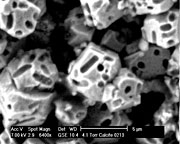- Number 330 |
- February 7, 2011
Coaxing bacteria to build cement prisons for old radioactive waste

An electron microscope view
reveals calcite crystals with
pill-shaped impressions left
by the bacteria that generated
the crystals.
Researchers at DOE’s Idaho National Laboratory, the Center for Advanced Energy Studies, and other national labs and universities are working together to test an inexpensive method to sequester old strontium-90 contamination in the ground where it lies.
The researchers can coax underground microbes to form calcite, which should be able to trap strontium-90 until long after it has decayed into harmless zirconium. Strontium-90 has a nearly 30-year half-life, which means that a sample of the stuff will take around 300 years to decay more or less completely.
When people consume strontium-90 in contaminated food or drinking water, the radioactive isotope can replace some of the calcium in living bone. The bone-bound strontium-90 acts as a long-term source of damaging radiation that can spawn deadly cancers of blood, bone and skin.
Cleaning strontium-90 out of the ground and water hasn't been easy. Some of the most contaminated dirt was excavated, but digging up all the contamination would be astronomically expensive. And a project to pump out and treat contaminated groundwater only removed a tenth as much strontium-90 as did natural decay during the same period.
So instead of trying to strip strontium-90 out of the ground, the research team is trying to get microbes to set a trap for it in the ground. The researchers are betting that the same chemical similarity that draws strontium-90 to bone will bind it into a microbe-made calcite "prison."[Nicole Stricker, 208.526.5955,
nicole.stricker@inl.gov]
